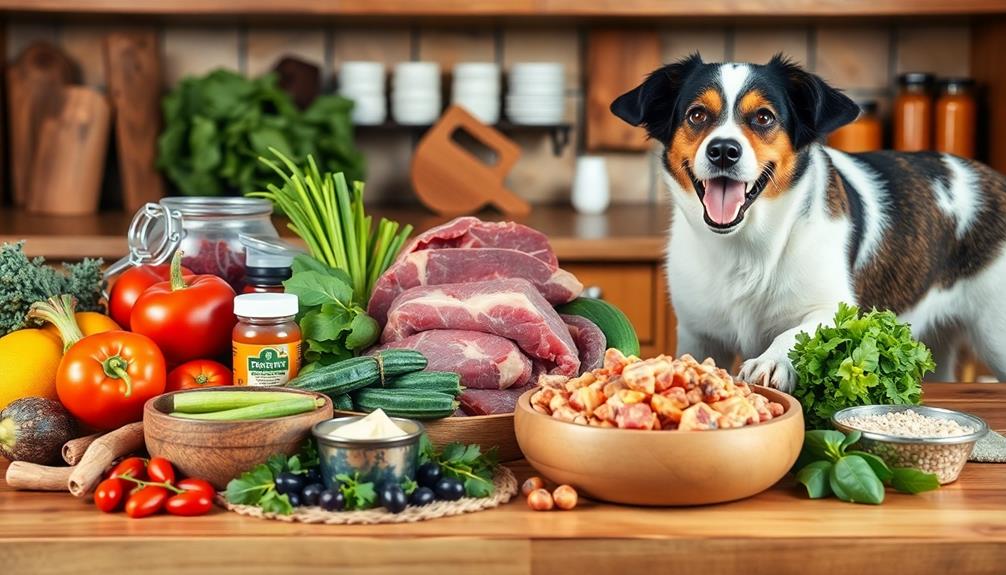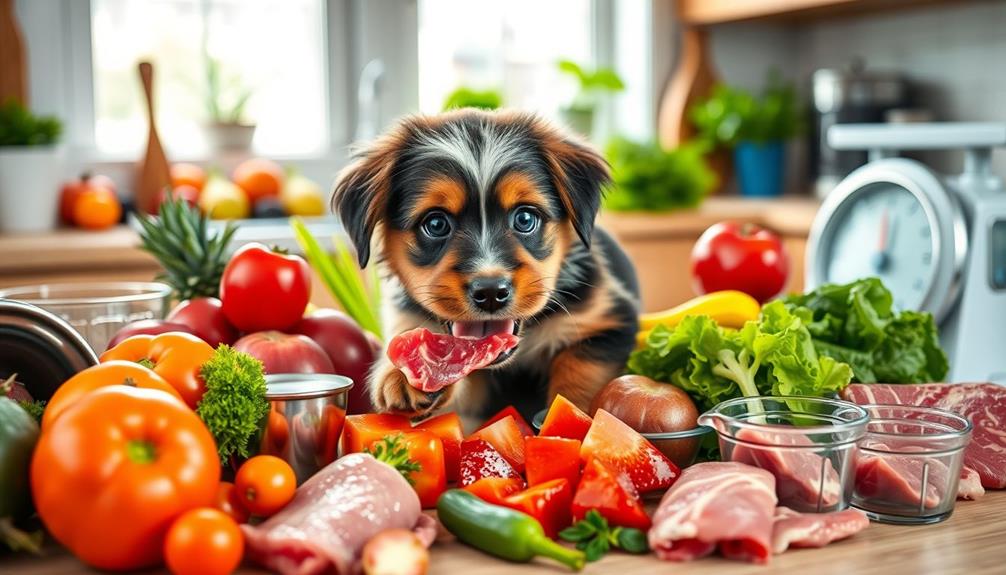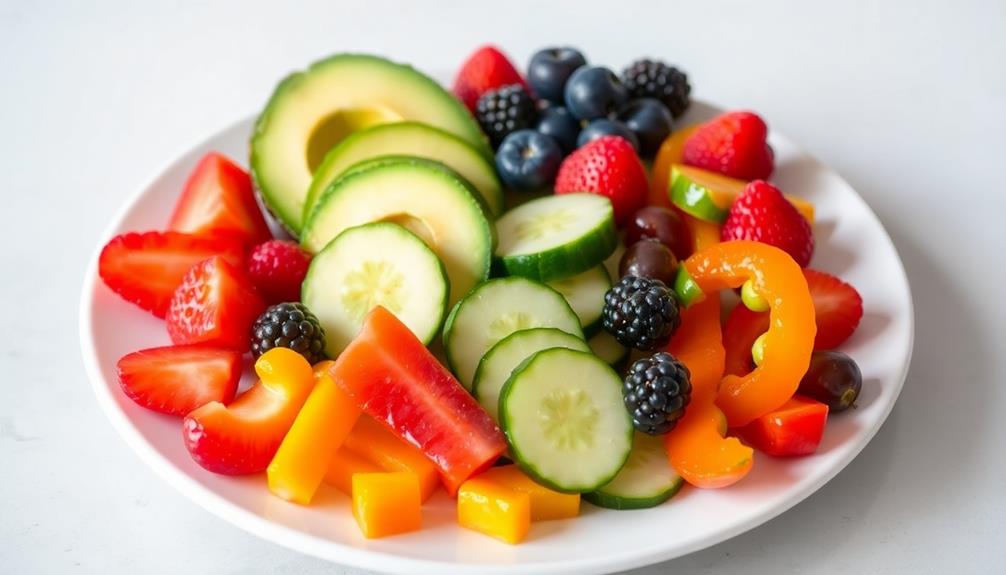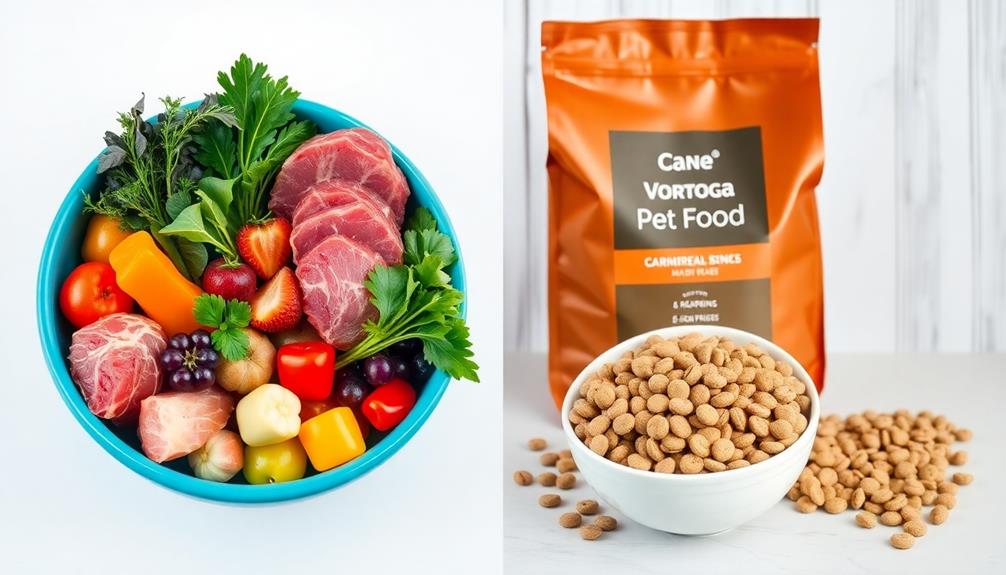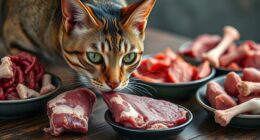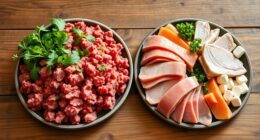When you need emergency raw pet food alternatives, consider freeze-dried or dehydrated options. These products maintain nutritional integrity while being easy to store and prepare. They usually contain over 90% meat, providing plenty of protein for your pet's needs. Many brands cater to specific dietary restrictions, ensuring your dog gets the right nutrition without risks associated with raw food. With quick rehydration and a long shelf life, they're perfect for unexpected situations. Plus, proper handling and gradual introduction are vital for safety. There's more information available that can help you make informed choices for your furry friend.
Key Takeaways
- Freeze-dried and dehydrated dog foods provide balanced nutrition with a long shelf life, ideal for emergencies without spoilage concerns.
- High meat inclusions in these alternatives ensure rich protein sources for lean muscle support during unexpected situations.
- Quick rehydration of freeze-dried options allows for fast meal preparation in emergencies, taking only 3 to 10 minutes.
- Grain-free freeze-dried choices cater to dogs with dietary restrictions, ensuring all pets receive appropriate nutrition during emergencies.
- Proper storage and handling of these alternatives minimize contamination risks, making them safe options for emergency feeding.
Overview of Raw Food Alternatives
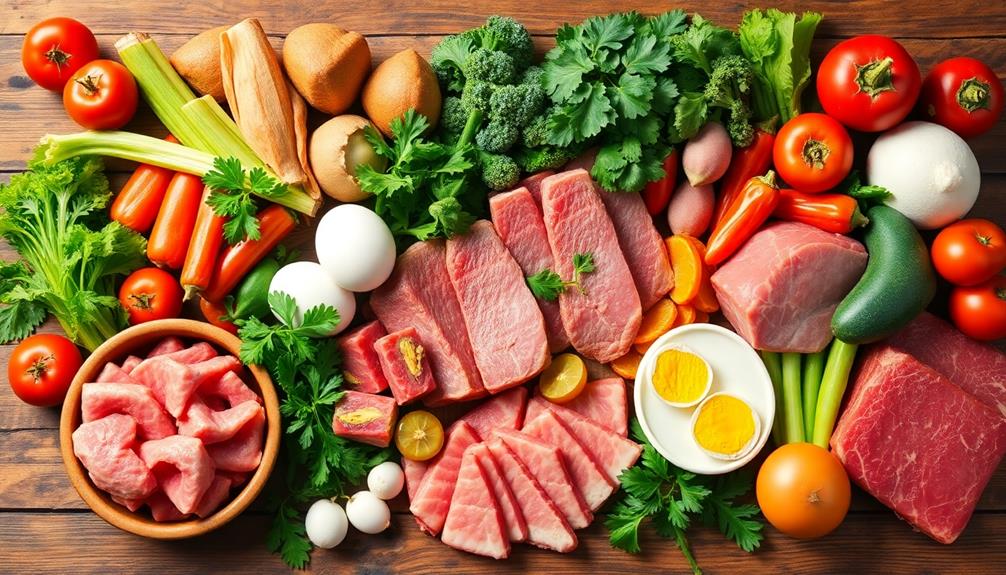
When it comes to feeding your dog, raw food alternatives offer a convenient and safe way to provide balanced nutrition without the risks associated with raw diets.
These raw dog food alternatives, such as freeze-dried and dehydrated options, maintain nutritional integrity while being shelf-stable. This makes them perfect for emergency meals when you can't access regular dog food.
Many of these commercial alternatives are formulated to meet AAFCO standards, guaranteeing that they deliver complete and balanced nutrition. This means you don't need to worry about additional supplementation, which simplifies your feeding routine.
You can also create convenient meal replacements by combining two parts protein, one part grain, and vegetables, allowing you to adapt easily during times of need.
High-quality brands like Dr. Harvey's and Ziwi Peak provide a variety of options that include superfoods and high inclusions of meat, ensuring your dog gets the essential nutrients they require.
These alternatives not only support overall pet health but also offer you peace of mind knowing you're providing safe and nutritious meals for your furry friend, even in unexpected situations.
Nutritional Benefits of Alternatives
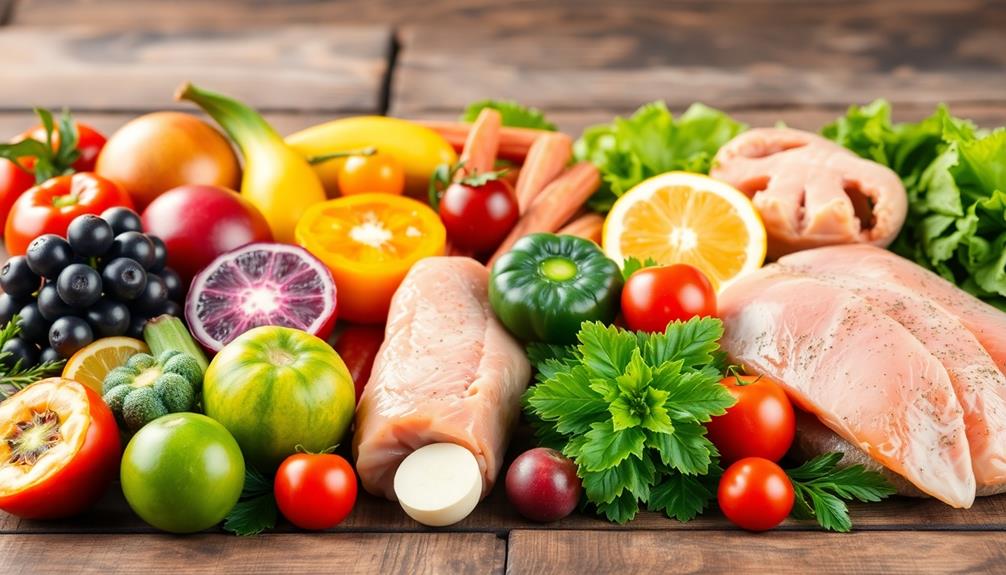
Raw food alternatives aren't just convenient; they also pack a punch regarding nutritional benefits. High-quality raw pet food alternatives, such as freeze-dried and dehydrated options, offer a balanced nutritional profile that meets your dog's dietary needs.
These alternatives guarantee your furry friend gets essential vitamins and minerals without the hassle of supplementation.
Here are some key benefits:
- Over 90% meat inclusions provide a rich source of protein to support lean muscle mass.
- Formulations cater to dogs with allergies or sensitivities, assuring they enjoy their meals.
- Low-temperature processing helps retain the nutritional integrity of raw ingredients, preserving crucial vitamins and enzymes.
- Easy storage and preparation make it simple for busy pet owners to provide nutritious meals.
Choosing these options means you can confidently nourish your pet while accommodating their unique dietary requirements.
With these alternatives, you're not just feeding your dog; you're giving them a delicious and healthy meal tailored to their needs.
Safety Considerations for Alternatives

Guaranteeing the safety of your pet while feeding them alternative diets is essential, especially with options like freeze-dried and dehydrated foods. These food alternatives undergo strict quality control measures and regular testing for contaminants, which helps minimize risks associated with raw feeding.
However, safety considerations don't stop there. Proper handling and preparation are vital to avoid foodborne illnesses, so always maintain hygiene during the feeding process.
When shifting to alternative diets, it's important to introduce new foods gradually. This approach allows you to monitor for any adverse reactions and guarantee your pet's digestive tolerance.
Consult a veterinarian or a veterinary nutritionist before making any changes to your pet's diet. They can help you assess the specific nutritional needs of your pet and address any safety concerns.
Exploring Freeze-Dried Options
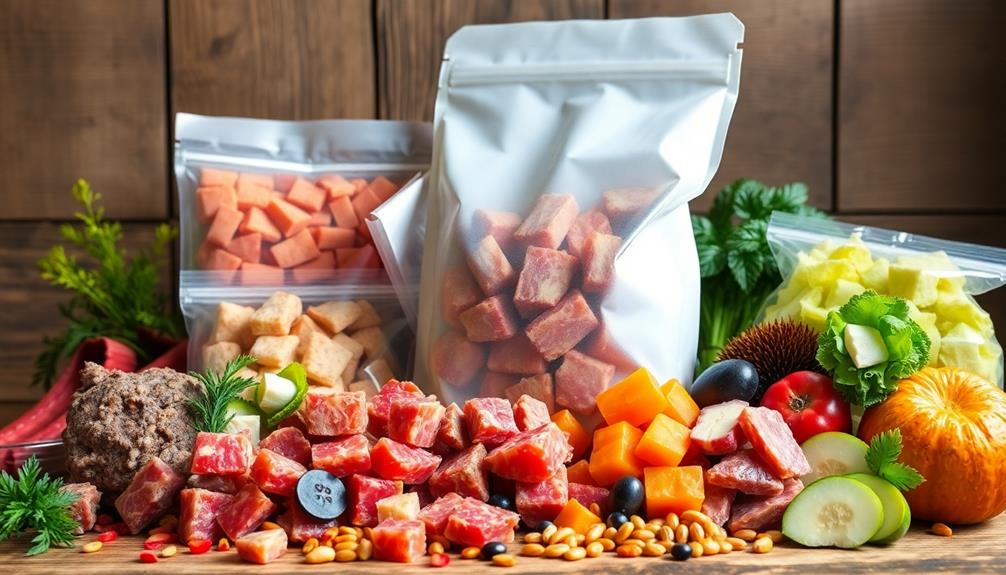
If you're considering safe and convenient alternatives for your pet's diet, freeze-dried options offer a promising solution. These dog food alternatives maintain nutritional integrity by preserving up to 90% real meat without artificial hormones or additives. The freeze-drying process locks in essential nutrients while ensuring your furry friend gets the best.
Here are some emotional benefits of choosing freeze-dried options:
- Quick rehydration: Just add water, and your pet's meal is ready in 3 to 10 minutes!
- Grain-free choices: Perfect for dogs with specific dietary restrictions or allergies.
- Long shelf life: Stock up for emergencies without worrying about spoilage.
- Convenient feeding: Great for travel or busy days when you need a hassle-free meal solution.
With freeze-dried dog food, you can feel confident knowing you're providing a nutritionally complete meal. Many options cater to specific dietary restrictions, ensuring your pet gets the essential nutrients they need.
Plus, their ease of storage makes them an ideal emergency food choice. Explore these freeze-dried options, and give your pet the quality diet they deserve, even in unexpected situations.
Best Dehydrated and Air-Dried Foods
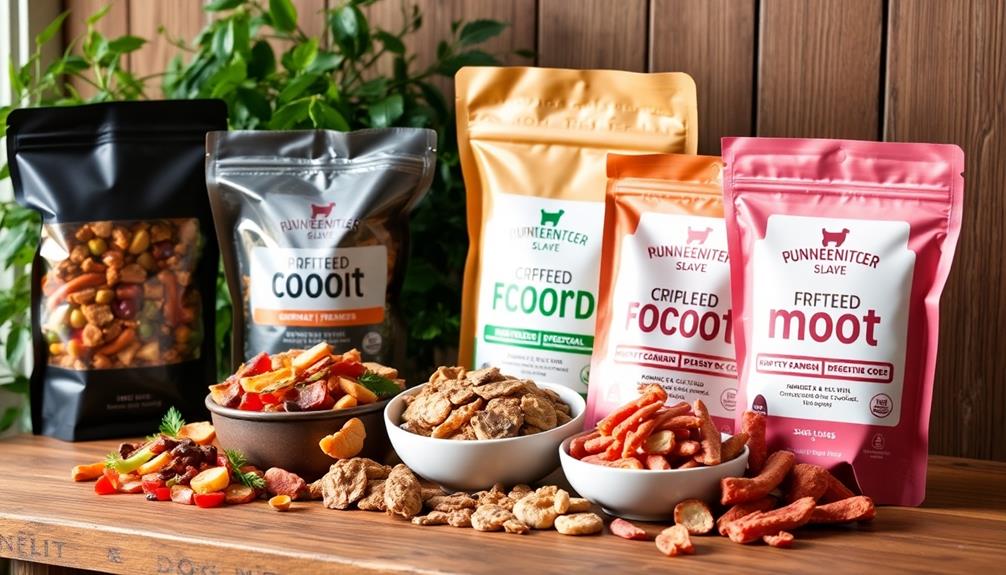
When it comes to emergency food options, dehydrated and air-dried dog foods stand out for their convenience and nutritional benefits. Dehydrated dog foods, like Dr. Harvey's and The Honest Kitchen, offer balanced nutrition without needing any supplementation. They're easy to store and prepare, making them perfect for unexpected situations.
Additionally, these foods often contain high levels of antioxidants and vitamins, similar to the health benefits seen with celery juice consumption, promoting overall well-being for your pet.
Air-dried foods, such as Ziwi Peak and Grandma Mae's, maintain the nutrient integrity of raw ingredients while using low temperatures to evaporate moisture. This process results in a shelf-stable product that's rich in high-quality protein sources.
If you want even quicker meal preparation, freeze-dried options like Boss Dog Lamb and Bravo! Turkey can be rapidly rehydrated with water, allowing for on-the-go feeding.
Many of these dehydrated and air-dried foods are also grain-free, catering to dogs with specific dietary restrictions. This guarantees you can provide your pup with the nutrition they need, even in emergency situations.
With quick meal preparation in mind, these options make it easy for you to keep your furry friend healthy and satisfied, no matter the circumstances.
Frequently Asked Questions
What Is a Good Alternative to Raw Dog Food?
If you're looking for good alternatives to raw dog food, consider high-quality freeze-dried or dehydrated options. You can also use cooked diets or commercial wet foods to guarantee your dog gets balanced nutrition.
What Is the Cheapest Way to Feed My Dog Raw?
Imagine a rustic farmhouse, where you gather fresh ingredients. To feed your dog raw cheaply, source bulk proteins from local farms, mix in affordable veggies, and prepare balanced meals at home. It's both simple and rewarding!
Which Dog Food Is Closest to Raw?
If you're looking for dog food closest to raw, consider freeze-dried or air-dried options. They preserve nutrients and protein levels, closely mimicking a raw diet while offering convenience and shelf stability for your pup.
How Do You Make Emergency Dog Food?
To make emergency dog food, combine two parts cooked protein, one part cooked grain, and one part cooked vegetables. Verify everything's cooked thoroughly, avoid added seasonings, and store leftovers in the fridge for up to three days.
Conclusion
To sum up, when you're in a pinch for pet food, exploring raw food alternatives can be a game-changer. Did you know that over 70% of pet owners believe that a raw diet improves their pet's overall health? By considering freeze-dried, dehydrated, or air-dried options, you can provide your furry friend with the nutrition they need while ensuring their safety. Always remember to consult with your vet before making any significant diet changes to keep your pet healthy and happy.

